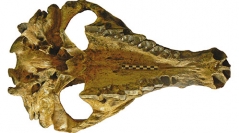

 Geodiversitas
35 (1) - Pages 155-205
Geodiversitas
35 (1) - Pages 155-205Among the numerous fossils discovered by the Fundação Museu do Homem Americano in the Serra da Capivara National Park region (Piauí, Brazil), we were able to identify two species of Toxodontidae from the Upper Pleistocene of North Eastern Brazil, Toxodon platensis Owen, 1837 et Piauhytherium capivarae n. gen., n. sp. Toxodon platensis is present in eight Northeastern sites, the most important being the Toca da Barra do Antonião, the Toca do Garrincho, (all two in São Raimundo Nonato, Piauí), the Lagoa dos Porcos in São Lourenço do Piauí, and Laje Grande in Pesqueira (PE). Forty remains belong to it. These remains are generally a little smaller than the homologous pieces from the type form of Argentina and Southern Brazil. We found Piauhytherium capivarae n. gen., n. sp. in nine Northeastern sites, essentially the Toca do Garrincho and the Lagoas São Vitor, do Quari, and dos Porcos, all from the Serra da Capivara National Park region. More than one hundred remains belong to it, including a skull and a mandible very well preserved. These are quite different from those of T. platensis, and teeth and post-cranial skeleton are different too. The teeth are clearly distinguishable form those of Trigodonops lopesi (Roxo, 1921) et Mixotoxodon larensis van Frank, 1957. At the Lagoa dos Porcos, the Toca do Garrincho (Piauí) and Fazenda Vista Alegre in Taperoá (PB) P. capivarae n. gen., n. sp. is sympatric with T. platensis. The limb segments ratios show that P. capivarae n. gen., n. sp., like T. platensis, had an periaquatic hippopotamus way of life.
South America, taxonomy, biometry, palaeoecology, Piauí, new genus, new species